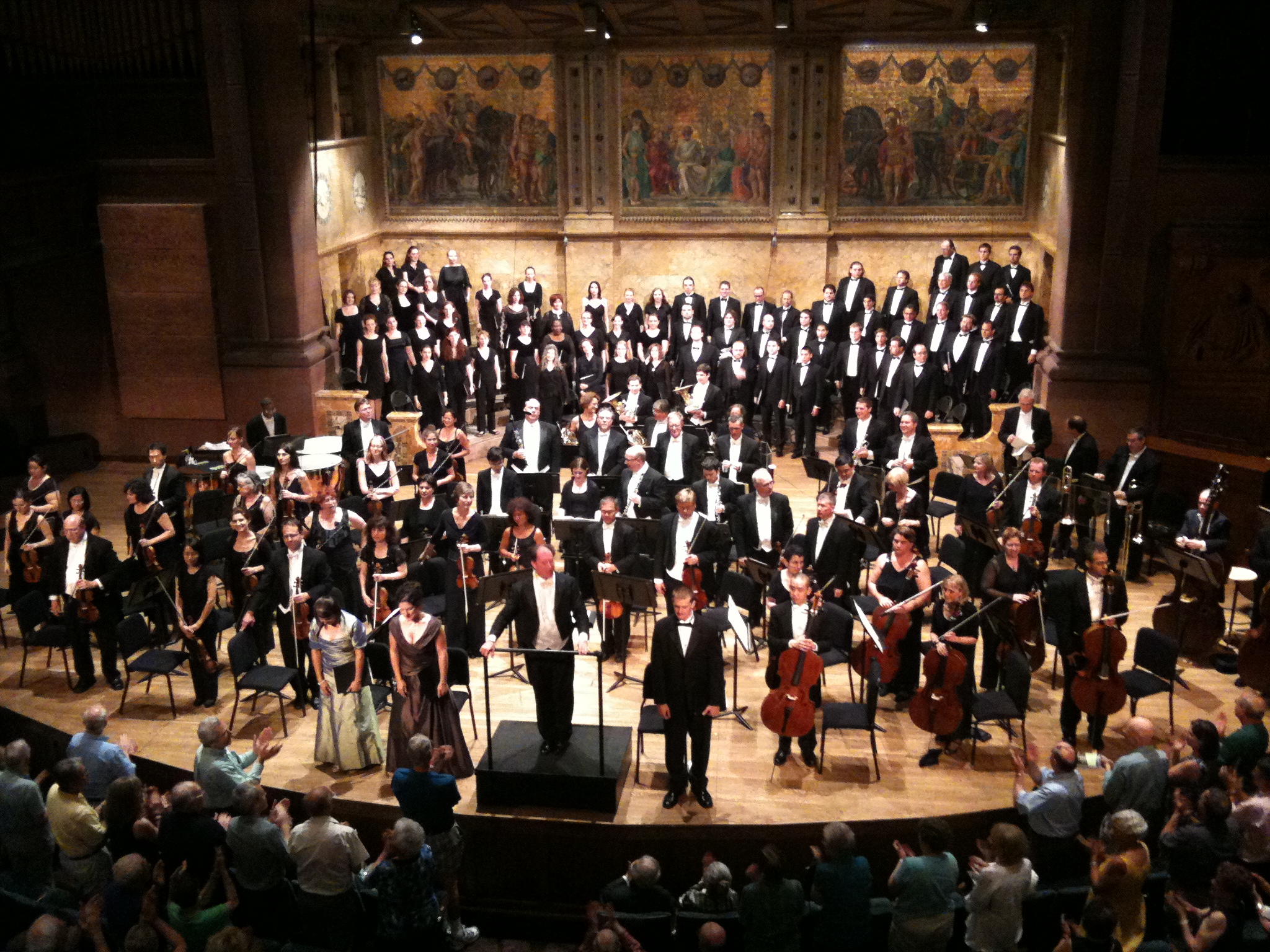Princeton, July 21, 2011.
Conductor Mark Laycock really knows how to get players fired up. He returned to Princeton this summer to conduct Opera New Jersey’s production of The Barber of Seville as well as leading the New Jersey Symphony in the Third annual William and Judith Scheide Concert: Exploring Mendelssohn and the Gutenberg Bible in Richardson Auditorium. The Scheide’s own copies of the Gutenberg bible which are housed in the Scheide library on the Princeton campus.
The all Mendelssohn concert started with the well known A Midsummer Night’s Dream Overture, Op. 21. Mendelssohn’s ethereal orchestration did not benefit from a modern addition: the Richardson Auditorium’s fire alarm system. The performance was only a third of the way into the score before the sold out house had to be evacuated. The performers and audience had to wait on the lawn for a half hour in near 100 degree weather. Several of the musicians made the best of the situation – lively Celtic tunes played on a penny-whistle to a fiddle accompaniment floated through the midsummer night.

After the orchestra reassembled, Laycock took “blame” for the fire alarm. Explaining from the podium he jested “I asked [the musicians] for more fireFLIES!” The actual problem was that there was “too much heat” in the building. A full house during a heat wave produced too much heat. Princeton has the latest technology don’t you know.
The concert resumed the concert in its entirety. The well known – and well played – overture (which was written in one day! August 6, 1826) whetted my appetite for the heart of the program.
The two other works on the program were written for the Leipzig Gutenberg-Festival in June 1840. This festival was part of a celebration of the 400th anniversary of his invention of the printing press. The Festgesang was performed on June 24 outdoors in Leipzig’s Market Square where a statue of Gutenberg was dedicated. The Symphony was premiered the following day in the Thomaskirche.
The Festgesang is scored for men’s chorus, two brass choirs and timpani. I did an exhaustive search for a recording only to discover that no commercial recording exists! It is certainly not every day that you hear a “new” work by Mendelssohn! Laycock took advantage of the Richardson Auditorium’s architecture by placing the smaller brass choir in and alcove above and to the right of the stage for a wonderful antiphonal effect. Such an arrangement is fraught with the dual problems of balance and simply dealing with the “delay” due to the placement of the players and the resonance of the hall. In this performance the three choirs were
There are four movements in the Festgesang.
- Choral. Begeht mit heil’gem Lobgesang
- Lied. Vaterland, in deinen Gauen
- Allegro molto. Der Herr, der sprach: Es werde Licht!
- Choral. Heil ihm! Heil uns!
In Adolf E. Proelss’ original libretto, the text to the Lied ( the second movement) praises Gutenberg. The music is thoroughly familiar. In 1855, the English organist William Hayman Cummings replaced this movement’s text with Charles Wesley’s Christmas hymn text, “Hark, the Herald Angels Sing”, which was subsequently published by J.J. Ewer & Co. on December 24, 1855. This makes the lack of a recording doubly puzzling! It would have been nice if the clumsy program notes did not give away the surprise beforehand.
For the final work, the Symphony No. 2, “Lobgesang”, Op. 52, the orchestra was joined by the Opera New Jersey Chorus along with sopranos Maria D’Amato and Sarah Asmar and tenor Joshua Kohl. The text consists of verses from Martin Luther (1483–1546), German translation of the Bible (Psalms 150, 33, 145, 103, 107, 56, 40, 116, and 96; and Ephesians 5, Isaiah 21, Romans 13, 1 Chronicles 16). The work begins with a purely instrumental three movement Sinfonia. The soloists and chorus then join forces with the orchestra for nine additional movements. It is easy for a work that calls for such forces to degenerate into a wash of gray. The conductor did not allow this to happen in this case. The first movement’s opening motto was assertive (and for me is still an ear-worm a day later). The Sinfonia’s Allegretto middle movement was graceful and well balanced. The eighth movement, based on Martin Rinckart’s (1586–1649) famous “Nun danket alle Gott” began quietly with the chorus alone. The orchestra enters gently, then builds to a climax and then subsides to a gentle conclusion. In a lesser performance the “seams” would show. But tonight the integration between the chorus and the orchestra was, well, seamless.
